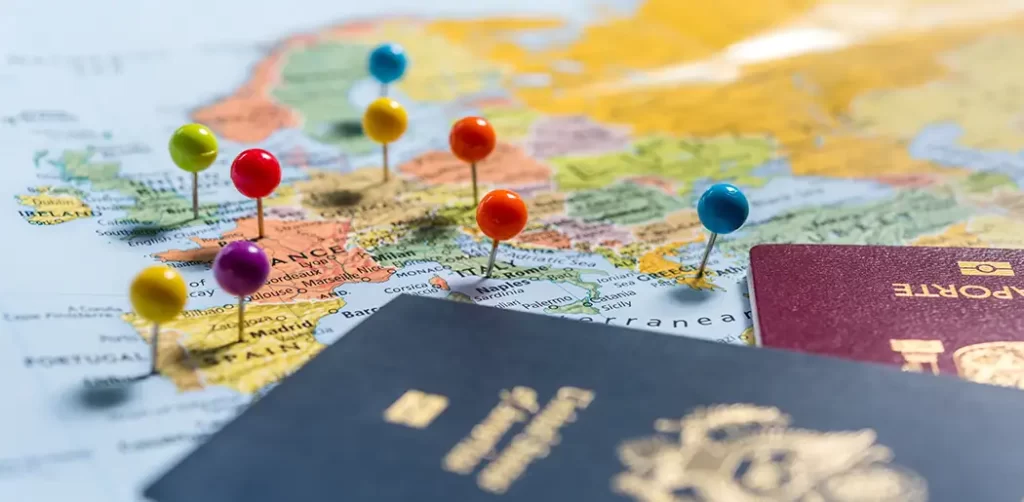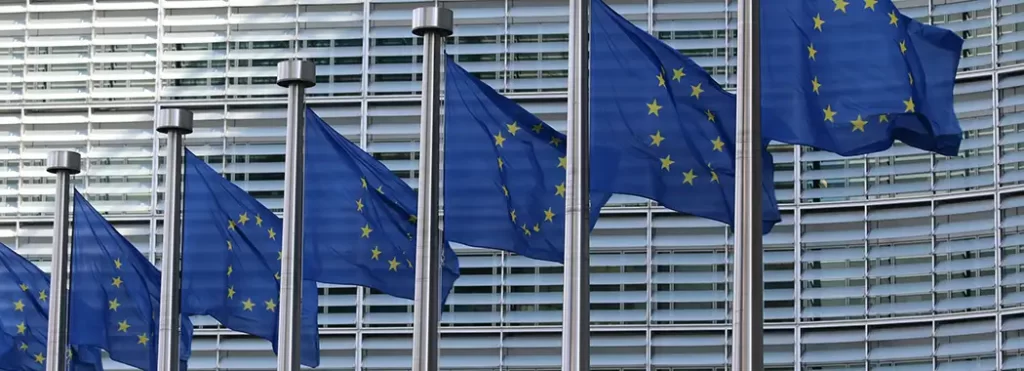
ETIAS 101: Streamlining Your European Journey in 2024 and Beyond
Are you dreaming of a European vacation? Starting in 2024, travelers from 60 visa-exempt countries, including the US, will need to navigate the new European Travel Information and Authorization System (ETIAS). This €7 (about $8 US) travel authorization, different from a traditional visa, is the European Union’s answer to enhancing security while ensuring a smooth entry into the Schengen Area—a collective of 30 countries without internal borders.

Designed for simplicity and to improve security, manage immigration, and protect both people and borders, ETIAS is valid for three years and is pivotal for boarding flights, ships, or buses to Europe. As global travel dynamics shift, this guide aims to demystify ETIAS, ensuring your European adventures remain as enchanting as ever.
- ETIAS 101: Streamlining Your European Journey in 2024 and Beyond
- Europe's ETIAS System: A New Era of Travel Authorization for Visa-Free Visitors
- OFFICIAL GOVERNMENT WEBSITES
- Europe's Answer to Secure and Streamlined Travel
- ETIAS Eligibility: Who Needs to Apply Before Traveling to Europe?
- ETIAS Application Checklist: Essential Documents and Information
- Avoiding ETIAS Scams: Spotting and Steering Clear of Unofficial Websites
- How to Apply for ETIAS: A Comprehensive Step-by-Step Guide
- ETIAS FAQs: Answering Your Top Questions About Europe's Travel Authorization
- Conclusion: The Importance of Staying Informed and Prepared for ETIAS
- Join the ETIAS Conversation: Share, Engage, and Discover Together
- Ready to Explore Europe? Let's Make It Happen Together!

Europe’s ETIAS System: A New Era of Travel Authorization for Visa-Free Visitors
Traveling to Europe has always been a dream for many, with its rich history, diverse cultures, and iconic landmarks. However, as the world changes, so do the requirements for international travel. If you’re planning a trip to Europe soon, there’s a new system you need to be aware of: ETIAS. The ETIAS is not a visa but rather a travel authorization.
ETIAS – European Travel Information and Authorization System
ETIAS stands for European Travel Information and Authorization System. It’s a new travel authorization system introduced by the European Union to enhance the security of both travelers and member countries.
People often confuse the ETIAS with the visa. While both are related to traveling in the Schengen Zone, they serve different purposes. The Schengen visa is for travelers from countries that require a visa to enter the Schengen Zone. On the other hand, the ETIAS is for travelers from visa-exempt countries, the United States being one of those countries.

Why is ETIAS Important?
With increasing global security concerns, the European Union aims to ensure safer and more secure travel within the Schengen Area. ETIAS will help pre-screen travelers from visa-exempt countries, identifying potential security risks before they reach European borders.
Who Will Be Affected?
If you’re a traveler from a visa-exempt country planning to visit the Schengen Area, ETIAS will be a crucial part of your travel preparations.
Ease of Process
While it’s a new requirement, the ETIAS application process is designed to be user-friendly and straightforward, ensuring travelers can obtain their authorization with minimal hassle.
In the sections that follow, we’ll delve deeper into the specifics of ETIAS, guiding you step-by-step on what you need to know and do. Whether you’re a seasoned traveler or planning your first European adventure, this guide aims to equip you with all the essential information about ETIAS.
OFFICIAL GOVERNMENT WEBSITES
Official ETIAS Website
travel-europe.europa.eu/etias_en
Official US Customs and Border Protection Website
https://www.cbp.gov/travel/international-visitors/esta

Europe’s Answer to Secure and Streamlined Travel
As international travel continues to grow, ensuring travelers’ and host countries’ safety and security becomes paramount. The European Union, with its open borders within the Schengen Area, recognized the need for a more robust system to screen travelers. Enter ETIAS.
What is ETIAS?
Definition: ETIAS, or the European Travel Information and Authorization System, is not a visa. Instead, it’s an electronic system that evaluates the eligibility of visa-exempt third-country nationals to enter the Schengen Zone.
Comparison: Think of ETIAS, the European Travel Information and Authorization System, as similar to the U.S.’s ESTA (Electronic System for Travel Authorization). It’s a pre-travel screening for travelers from countries that do not require a visa to visit Europe.

Why Was ETIAS Introduced?
Enhanced Security: With global security challenges on the rise, ETIAS provides an additional layer of security. It helps identify potential threats before they reach European borders.
Improved Management: ETIAS aids in managing the increasing number of travelers to Europe more effectively, ensuring a smoother entry process for legitimate travelers.
Health Concerns: Especially in the wake of global health crises, ETIAS can also assist in the early detection and reduction of potential health risks.

Primary Objectives of ETIAS:
Protecting Borders: By pre-screening travelers, ETIAS ensures that individuals posing security risks are identified before they arrive in the Schengen Area.
Facilitating Travel: ETIAS simplifies the entry process for travelers, reducing wait times and ensuring a more pleasant travel experience.
Boosting Tourism: By streamlining the entry process and enhancing security, Europe aims to remain a top travel destination while ensuring the safety of both its residents and visitors.
While ETIAS introduces an additional step for travelers, its primary goal is to create a safer, more secure, and more efficient travel experience for everyone involved.

ETIAS Eligibility: Who Needs to Apply Before Traveling to Europe?
Navigating the requirements of international travel can sometimes be a maze. With the introduction of ETIAS, you might wonder if it applies to you. Let’s break down the specifics.
Eligibility Criteria:
Visa-Exempt Travelers: ETIAS is designed for travelers from countries that do not require a visa to enter the Schengen Area. If you’re from a visa-exempt country and plan to visit Europe for short stays, you’ll need to apply for ETIAS.
US Travelers: As an example, travelers from the United States, being visa-exempt for tourism in Europe, will need to obtain an ETIAS authorization before their trip.

Duration of Stay Covered by ETIAS:
ETIAS allows short visits to the Schengen Area, up to 90 days within a 180-day span. Other visa types might be required if you plan a more extended visit or have different purposes like employment or residence.
Exemptions: Who Doesn’t Need ETIAS?:
Young and Elderly Travelers: Certain age groups, such as children under a specific age and elderly travelers above a certain age, might be exempted from the ETIAS requirement. (Note: Specific age criteria can vary and should be checked on the official ETIAS website.)
Holders of Diplomatic Passports: Individuals traveling on diplomatic or official passports for specific missions might be exempt.

Travel Reasons Covered by ETIAS VISA Exemption:
ETIAS is versatile and covers a range of travel purposes, including:
- Tourism: Exploring Europe’s landmarks, cultures, and attractions.
- Business: Short business trips, conferences, or meetings.
- Transit: Passing through Schengen countries to reach a non-Schengen destination.
- Medical: Short-term medical treatments or consultations.

List of Schengen Area Countries Requiring ETIAS for Entry:
The Schengen Area is a unique travel zone comprising 30 European countries that have come together to abolish passport control at their mutual borders, allowing for smoother and more efficient travel within the region. If you’re planning to visit any of these ETIAS countries and are from a visa-exempt nation, you’ll need to apply for ETIAS:

- Austria
- Belgium
- Czech Republic
- Denmark
- Estonia
- Finland
- France
- Germany
- Greece
- Hungary
- Iceland (Note: While Iceland is not a member of the European Union, it is a member of the Schengen Area.)
- Italy
- Latvia
- Lithuania
- Luxembourg
- Malta
- Netherlands
- Norway (Note: Like Iceland, Norway is not a member of the European Union but is part of the Schengen Area.)
- Poland
- Portugal
- Slovakia
- Slovenia
- Spain
- Sweden
- Switzerland (Note: Switzerland is another non-EU country that is part of the Schengen Area.)
Additionally, 4 other countries Bulgaria, Romania, Cyprus, and Croatia who are not yet part of Schengen Agreement will be part of ETIAS. The list of countries keeps growing. Make sure to check the official ETIAS website for up-to-date info on ETIAS countries.
It’s essential to remember that while the Schengen Area facilitates travel between these countries without internal border checks, travelers must still meet the entry requirements of the first Schengen country they enter. This is where ETIAS comes into play for visa-exempt travelers.
If you’re a traveler from a visa-exempt country planning a short trip to the Schengen Area, it’s essential to check if ETIAS applies to you and ensure you have the necessary authorization before your journey.

ETIAS Application Checklist: Essential Documents and Information
Preparing in advance is the key to a smooth application process. Before you start your ETIAS application, gather the following essentials to ensure a hassle-free experience:
Valid Passport Requirements:
Ensure your passport is valid for a minimum of 3 months after your planned departure date from the Schengen Area and that it was issued in the last 10 years.
Necessary Personal and Contact Details:
- Full Name: As it appears on your passport.
- Date and Place of Birth.
- Gender.
- Nationality.
- Current Address.
- Email Address: Make sure to provide a valid email address, as they will use it for all ETIAS communications.
- Phone Number: While not always mandatory, it’s good to provide for any urgent communications.

Information About Travel Itinerary:
While detailed plans are beneficial, the primary requirement is to specify the first Schengen country you plan to visit.
Security-Related Questions:
These questions will cover areas related to health, criminal history, and previous travel to conflict zones. Answering honestly is crucial, as discrepancies can lead to application denial or complications during your trip.
Payment Methods for the ETIAS Fee:
You need a valid credit or debit card to pay the ETIAS application fee. Make sure the card has enough funds to cover the fee.
Suitable Digital Devices for the Application Process:
The ETIAS application is online based. You can use a:
- Desktop Computer.
- Laptop.
- Tablet.
- Smartphone. Ensure you have a stable internet connection during the application.
Estimated Time to Complete the Application:
On average, filling out the ETIAS application takes 10 to 20 minutes. However, it’s advisable to set aside a bit more time to review your answers carefully before submission.
Remember, they designed the ETIAS application for user-friendliness. With all the required information ready, you’ll easily navigate the process and move one step closer to your European adventure.

Avoiding ETIAS Scams: Spotting and Steering Clear of Unofficial Websites
The digital age, while offering convenience, also brings the challenge of navigating a sea of information. With the introduction of ETIAS, numerous websites have sprung up claiming to provide official ETIAS services. It’s crucial to tread carefully.
The Rise of Misleading and Unofficial ETIAS Platforms:
Pretense of Authenticity: Many unofficial websites appear professional and authentic, often mimicking the design and language of official platforms.
Misinformation: These sites may provide incorrect or misleading information about ETIAS, leading to confusion and potential complications for travelers.
Illegitimate Charges: Some unofficial platforms might charge exorbitant fees, far more than the official ETIAS application cost.

Risks Associated with Sharing Information on Unverified Sites:
Data Theft: Unofficial sites might not have secure data protection measures, putting your personal and financial information at risk.
Misuse of Personal Data: There is a risk that someone might sell or misuse your personal information for other purposes.
Application Complications: Applying through an unofficial site might lead to errors in your application or even result in a fake ETIAS authorization.
How to Identify and Avoid Scam Sites:
Check the URL: The official ETIAS website https://travel-europe.europa.eu/etias_en will have a domain associated with the European Union (.eu). Be wary of sites with unusual or long domain names.
Look for Official Endorsements: The official ETIAS site will likely have endorsements or links from official European Union entities.
Review the Fee Structure: If the site charges significantly more than the known ETIAS fee, currently 7€ it’s a red flag.
Research Reviews and Feedback: A quick online search can often reveal feedback from other travelers who might have encountered the unofficial site.
Trust Your Instincts: If something feels off or too good to be true, it probably is. Always opt for caution.
While the digital world offers convenience, it also requires vigilance. Ensure you’re using the official ETIAS platform for your application to guarantee security, accuracy, and peace of mind.

How to Apply for ETIAS: A Comprehensive Step-by-Step Guide
Embarking on a European adventure soon? The ETIAS application process is straightforward, but knowing what to expect is always helpful. Here’s a step-by-step guide to ensure your application is smooth and successful:
- Visit the Official ETIAS Website:
- Start by navigating to the official ETIAS website https://travel-europe.europa.eu/etias_en . Remember to double-check the URL to ensure you’re on the authentic platform.
- Fill in Personal, Passport, and Travel Details:
- Personal Details: This includes your full name, date of birth, gender, and contact information.
- Passport Details: Ensure you have your valid passport on hand to input details like passport number, issuance date, and expiry date.
- Travel Itinerary: Specify the first Schengen country you plan to visit and, if possible, provide a brief overview of your travel plans within the Schengen Area.
- Answer the Security and Health-Related Questions:
- These questions aim to assess any potential risks associated with your visit. Topics might cover previous travel to conflict zones, criminal history, and health concerns. Answer all questions honestly and to the best of your knowledge.
- Pay the Application Fee Using a Secure Payment Method:
- The fee for ETIAS is set at a specific amount (e.g., €7 euros for most adults or about $8 US). Use a valid credit or debit card to complete the payment. Ensure the transaction is secure and keep a receipt or confirmation of the payment.
- Await the ETIAS Decision via Email:
- Once you’ve submitted your application, the decision is typically quick, often within a few hours. However, it can take up to 96 hours in some cases. Ensure you check your email (including the spam folder) for the ETIAS decision.
- What to Do in Case of Application Denial or Further Verification:
- Denial: In the rare event your application is denied, the reason will be provided. You have the right to appeal the decision or, based on the reason for denial, correct any errors and reapply.
- Further Verification: In some cases, additional information or documents might be requested. Ensure you provide the required details promptly to avoid delays in your application.
While the ETIAS application adds another step for travelers, its design aims for user-friendliness. If you follow this guide and provide accurate details, you’ll soon be exploring the wonders of Europe!

ETIAS FAQs: Answering Your Top Questions About Europe’s Travel Authorization
Answer: Starting in 2024, officials will implement ETIAS as a mandatory requirement for eligible travelers. Travelers from visa-exempt countries must obtain this authorization before visiting the Schengen Area from that year onward. It’s recommend keeping up with official updates and making sure you meet all travel requirements before embarking on your trip.
Answer: Citizens from non-EU countries that are currently visa-exempt for short-term stays in the Schengen Area will need to apply for ETIAS. This includes travelers from about 60 countries including from the United States.
Answer: Travelers can apply for ETIAS through the official online portal. The process requires a valid passport, personal details, and a payment method for the application fee.
Answer: ETIAS is valid for three years from the date of issuance or until the expiry date of the passport used during the application, whichever comes first. Both US citizens and other approved ETIAS holders can stay in the Schengen Area for up to 90 days within a 180-day period for tourism, business, or transit purposes.
Answer: Adults must pay an application fee of EUR 7 (about $8 US) for ETIAS. The fee might not apply to certain age groups, like children under a specific age and elderly travelers. Always refer to the official ETIAS website to see the latest fee structure.
Answer: Yes, ETIAS allows for multiple entries into the Schengen Area during its validity period. However, remember that each stay should not exceed 90 days within any 180-day period.
Answer: If a traveler experiences a delay or if their ETIAS application is denied or not approved, they will be provided with a reason for the decision. Travelers have the right to appeal the denial. Alternatively, based on the specific reason given, they can address and correct any errors, discrepancies, or omissions and then reapply for ETIAS authorization.
Answer: If a delay occurs in processing or the ETIAS application doesn’t get approval, travelers will get a reason for the decision. They can appeal the denial or fix any discrepancies and apply again.
Answer: The official ETIAS website will have a domain associated with the European Union (.eu). Be cautious of sites with unusual or long domain names, exorbitant fees, or that provide misleading information. Always cross-check with official European Union sources or trusted travel advisories.
Answer: Yes, the ETIAS regulation allows commercial intermediaries to apply for the ETIAS travel authorization on behalf of travelers. However, it’s essential to ensure that the agency or intermediary is reputable and trustworthy to avoid potential issues or scams.
Answer: If you’re from a visa-exempt country and try to enter the Schengen Area without a valid ETIAS, you may be denied entry at the border. It’s crucial to ensure you have all the necessary authorizations before your trip to avoid complications.
Answer: The EU is introducing ETIAS to enhance the security of its borders and citizens. By pre-screening travelers from visa-exempt countries, the system aims to identify potential security and migration risks before they reach the Schengen Area.
Answer: ETIAS designers made it a straightforward online process, and most applications get approval within minutes. However, we advise travelers to apply for ETIAS well before their travel date to ensure they receive the necessary authorization for their trip.
Answer: ETIAS is an online system where travelers provide personal and travel details. The system checks this information against various databases to identify any potential security or migration risks. The system electronically links approved authorizations to the traveler’s passport.
Answer: The primary motivation behind ETIAS is to bolster the security of the European Union and its citizens. The system will help in identifying potential threats and ensuring safer travel within the Schengen Area.
Answer: No, US citizens do not need a traditional visa for short-term tourist or business trips to the Schengen Area. However, starting in 2024, they will need an ETIAS authorization.
Answer: With an approved ETIAS, Americans can visit all countries within the Schengen Area, which includes 30 European countries that have abolished passport control at their mutual borders. However, the list of countries keeps growing. Check with the office ETIAS website for the most current list of ETIAS countries.

Conclusion: The Importance of Staying Informed and Prepared for ETIAS
Traveling is an enriching experience, opening doors to new cultures, landscapes, and memories. However, the journey to any destination begins long before the flight takes off or the ship sets sail. It starts with being well informed and prepared.
This introduction of ETIAS underscores the evolving landscape of international travel. While it adds a layer to the travel preparation process, its primary goal is to ensure the safety and security of both travelers and the countries they visit. By understanding ETIAS and its requirements, travelers can ensure a smooth entry into the Schengen Area, making their European adventure all the more enjoyable.

It cannot be stressed enough how vital it is to use official channels when applying for travel authorizations like ETIAS. While tempting with their promises of expedited services or added conveniences, unofficial websites and intermediaries can often lead to complications, misinformation, or even potential scams.
Lastly, as with all travel regulations, it’s essential to stay updated. Rules, fees, and requirements can change, and being in the know ensures that you’re always a step ahead, ready to embark on your next adventure with confidence and peace of mind.
Safe travels and go make some lifelong memories.

Join the ETIAS Conversation: Share, Engage, and Discover Together
Travel is more than just a personal journey; it’s a shared experience with family, friends, and loved ones. As you prepare for your European adventure, consider the countless others who might benefit from the insights and information you’ve just gleaned.
- Share the Knowledge: If you found this guide helpful, don’t keep it to yourself. Share it with fellow travelers, friends, and family. Whether it’s through social media, email, or good old-fashioned word of mouth, spreading the word can make a difference in someone’s travel experience.
- Your Voice Matters: We value your feedback. Whether you’ve already navigated the ETIAS process or are just starting to plan your trip, your experiences and insights can be invaluable to others. Drop a comment below, share your stories, or offer tips that this guide might not have covered.
- Questions Welcome: The world of travel is vast and ever-changing. If you have additional questions or areas of concern not addressed here, please ask in the comments section. We, along with the community of travelers, are here to help.
Remember, you begin every journey with a single step, and informing yourself well is the first step towards a memorable European vacation. Let’s embark on this journey together!


Ready to Explore Europe? Let’s Make It Happen Together!
Navigating the new ETIAS travel authorization can be tricky, but you don’t have to do it alone. At Favorite Grampy Travels, we’ve got the expertise and the passion to make your European adventure a breeze.
Why stress over paperwork when you could be dreaming about the Eiffel Tower, the Colosseum, or a romantic gondola ride in Venice?
Book with Favorite Grampy Travels today, and let’s turn those dreams into reality! We’ll handle the planning, so all you have to do is pack your bags and get ready for the trip of a lifetime.
Click here to start your European adventure with Favorite Grampy Travels!

